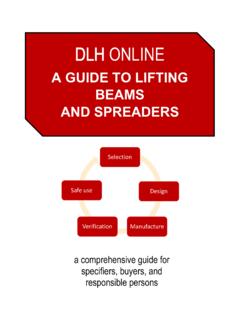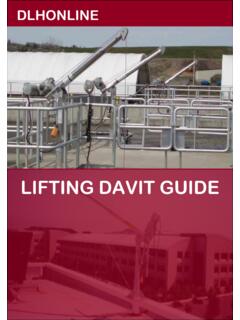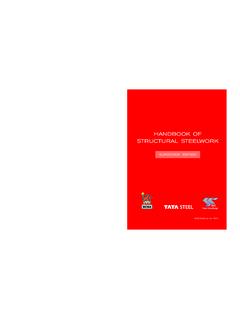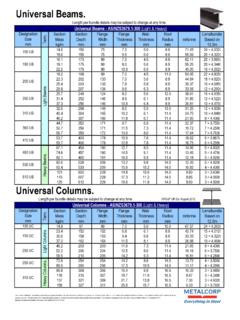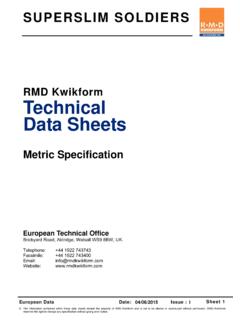Transcription of A GUIDE TO CLAMPS GRABS AND LUGS FOR LIFTING …
1 Tel: 0845 270 2919 - INT: 00 44 161 223 1990 - Email: - Web: 1 DLH ONLINE A GUIDE TO CLAMPS GRABS AND LUGS FOR LIFTING PURPOSES BenefitsTypesManufacturersApplicationsSa fe use Tel: 0845 270 2919 - INT: 00 44 161 223 1990 - Email: - Web: 2 A GUIDE to CLAMPS , GRABS and Lugs used for LIFTING Purposes Table of contents Sections Title Page 1 Overview 3 2 Types 5 3 Manufacturers 12 4 Standards 13 5 Instructions for safe use and maintenance 14 6 Contacting us 15 Tel: 0845 270 2919 - INT: 00 44 161 223 1990 - Email: - Web: 3 1. Overview In addition to various types of LIFTING slings which generally connect to the load by hooking into LIFTING points or wrapping around the load, there are numerous CLAMPS , GRABS , scissor tongs or LIFTING lugs which can safely connect to the load by gripping using friction or mechanical engagement with the load.
2 CLAMPS are the ideal tool for handling loads safely by overhead crane or hoist. CLAMPS like this steel plate clamp offer the ability to lift, up-end, manoeuvre and position the load in safety. CLAMPS can safely be used with a forklift truck. CLAMPS can be attached using a forklift hook attachment or a fork jib, effectively turning your crane into a mobile crane. This method of handling is much safer than balancing an unstable load over the forks and provides the ability to rotate and position the load much more safely and precisely. (Continued) Tel: 0845 270 2919 - INT: 00 44 161 223 1990 - Email: - Web: 4 CLAMPS and lugs can be used to lift a wide range of loads, including sheet material such as steel, or even for more complex shapes such as various rolled steel sections, there are purpose-made CLAMPS for pipes, cable drums, ISO Containers, steel, boards stone, steel and plastic drums or prefabricated concrete construction elements.
3 The clamping force can be produced in a variety of ways. The simplest is by means of a screw thread. Some designs incorporate cams or scissor mechanisms which utilise the weight of the load so that the gripping force produced is proportional to the weight being lifted. CLAMPS can also be power operated As well as gripping the load to lift it, many CLAMPS incorporate the facility to tilt, rotate or orientate the load in some way. This is particularly useful for loads which need to be stored or transported in one plane but presented for use in another.. Tel: 0845 270 2919 - INT: 00 44 161 223 1990 - Email: - Web: 5 2. Types of CLAMPS Let us now look at some of the more common types. CLAMPS for LIFTING sheet material are generally referred to as plate CLAMPS and there are two basic types: horizontal plate CLAMPS and vertical plate CLAMPS .
4 Horizontal Plate CLAMPS As the name implies, horizontal plate CLAMPS only handle plate laid flat. They are therefore always used in pairs, one either side of the plate, in conjunction with a two leg sling. The CLAMPS rely on either a lever or cam to grip the plate and the angle of the sling leg must be such as to give the correct line of pull. Therefore the length of the sling legs must be matched to the width of the plate. Longer plates often need more than one pair of CLAMPS to be adequately supported in which case they are used in conjunction with a LIFTING beam . Variations of this type of clamp include designs for handling single plates within a range of thickness, to be adjustable to handle several ranges, or to handle bundles of several plates.
5 Tel: 0845 270 2919 - INT: 00 44 161 223 1990 - Email: - Web: 6 Vertical Plate CLAMPS The original designs of vertical plate CLAMPS were intended only to lift plate in the vertical plane or lay it down from the vertical in one direction only. Attempting to lower the plate in the opposite direction caused the mechanism to release the plate. They could not therefore be used to turn over plates in a single movement. Another limitation of early designs was that the weight of the LIFTING machine hook bearing down in the clamp LIFTING eye could also release the grip. Modern designs are rather more sophisticated and much safer. However they still have their limitations and it is essential to understand them and select the appropriate design for the particular application.
6 The simplest designs utilise a screw thread which is manually tightened to grip the load. They are particularly useful for applications where the clamp is to be left in place between a series of handling operations. The majority of vertical plate CLAMPS use a cam giving a clamping force which is proportional to the load. Generally the initial grip of cam types comes from a spring operated by a lever which the user flips over into the locked position after positioning the clamp on the plate. Vertical plate CLAMPS can only lift one plate at a time. Generally the line of pull should be square to the plate edge but most manufacturers also make a " universal " type which allows the line of pull to be at an angle to the edge.
7 Tel: 0845 270 2919 - INT: 00 44 161 223 1990 - Email: - Web: 7 Soft Jaw Plate CLAMPS CLAMPS intended for LIFTING steel plate generally have sharp teeth which bite into the plate, giving a degree of mechanical connection rather than relying just on friction. However there are non-marking CLAMPS designed to handle plates of harder material or which have delicate surfaces where indentations from the clamp teeth would be unacceptable. Pile CLAMPS Another variation of the vertical types are CLAMPS designed to be released remotely, typically for applications such as pile pitching. Container LIFTING Lugs LIFTING lugs for top or bottom side connection to ISO containers. Tel: 0845 270 2919 - INT: 00 44 161 223 1990 - Email: - Web: 8 Steel Section CLAMPS and GRABS Other steel sections such as tubes, angles, channels, universal beams and railway lines can all be lifted by standard CLAMPS designed for the particular section.
8 Girder CLAMPS Girder CLAMPS which locate onto the flange of a beam are available either as a suspension point from a steel structure. Or as a means of attaching to a steel beam in order for the clamp to lift it from one flange and place the beam adjacent to others or from the web at the ends of the beam using a two leg sling. Tel: 0845 270 2919 - INT: 00 44 161 223 1990 - Email: - Web: 9 Case and Pack GRABS GRABS for loads with parallel sides, these can have spikes or pads for delicate loads Pre-Cast Concrete Segment GRABS There are many applications in the construction industry for CLAMPS to handle pre-cast concrete components. Whether it is manhole segments, kerbstones, safety barriers, pipes or any other pre-cast concrete products, there are CLAMPS designed to lift and position them.
9 A frequent problem with such products is that they have no natural LIFTING points by which to attach slings and they have to be landed in such a way that would trap slings wrapped around them. CLAMPS offer a method of connecting to the load so that it may be presented tight up to a neighbouring component without trapping the LIFTING equipment. (Continued) Tel: 0845 270 2919 - INT: 00 44 161 223 1990 - Email: - Web: 10 Moreover, because they have been designed for the particular application, it is relatively easy to locate them in exactly the correct position every time when LIFTING a series of identical components. The clamp can also incorporate a mechanism for orientating the load so, for example, the facing panel of a building can be transported and stored flat but lifted and turned to the vertical and presented to the building for fixing.
10 Some CLAMPS are designed specifically as permanent attachments to a hydraulic arm on a road vehicle or site truck. However, many similar CLAMPS are designed to work on the hook of a crane. They can be power operated but are often of a simple mechanical design using a scissor -mechanism which generates a clamping force in proportion to the load lifted. The self-weight of the clamp tends to close it and therefore provides the initial grip. They have to be locked open in order to release the load and this can be by means of either a manual lever or by an automatic latch. Tel: 0845 270 2919 - INT: 00 44 161 223 1990 - Email: - Web: 11 Drum CLAMPS In addition to drum CLAMPS which slide-on to the forks of forklift trucks, there is a wide range of drum lifters for use with an overhead crane or hoist.
